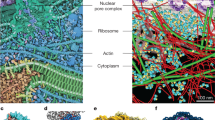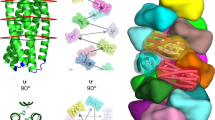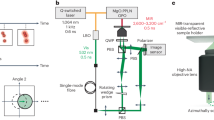Abstract
Chromophores absorb light in photosensitive proteins and thereby initiate fundamental biological processes such as photosynthesis, vision and biofluorescence. An important goal in their understanding is the provision of detailed structural descriptions of the ultrafast photochemical events that they undergo, in particular of the excited states that connect chemistry to biological function. Here we report on the structures of two excited states in the reversibly photoswitchable fluorescent protein rsEGFP2. We populated the states through femtosecond illumination of rsEGFP2 in its non-fluorescent off state and observed their build-up (within less than one picosecond) and decay (on the several picosecond timescale). Using an X-ray free-electron laser, we performed picosecond time-resolved crystallography and show that the hydroxybenzylidene imidazolinone chromophore in one of the excited states assumes a near-canonical twisted configuration halfway between the trans and cis isomers. This is in line with excited-state quantum mechanics/molecular mechanics and classical molecular dynamics simulations. Our new understanding of the structure around the twisted chromophore enabled the design of a mutant that displays a twofold increase in its off-to-on photoswitching quantum yield.
This is a preview of subscription content, access via your institution
Access options
Access Nature and 54 other Nature Portfolio journals
Get Nature+, our best-value online-access subscription
$29.99 / 30 days
cancel any time
Subscribe to this journal
Receive 12 print issues and online access
$259.00 per year
only $21.58 per issue
Buy this article
- Purchase on Springer Link
- Instant access to full article PDF
Prices may be subject to local taxes which are calculated during checkout





Similar content being viewed by others
References
Dean, K. M. & Palmer, A. E. Advances in fluorescence labeling strategies for dynamic cellular imaging. Nat. Chem. Biol. 10, 512–523 (2014).
Weber, W., Helms, V., McCammon, J. A. & Langhoff, P. W. Shedding light on the dark and weakly fluorescent states of green fluorescent proteins. Proc. Natl Acad. Sci. USA 96, 6177–6182 (1999).
Maddalo, S. L. & Zimmer, M. The role of the protein matrix in green fluorescent protein fluorescence. Photochem. Photobiol. 82, 367–372 (2006).
Tsien, R. Y. The green fluorescent protein. Ann. Rev. Biochem. 67, 509–544 (1998).
Voityuk, A. A., Michel-Beyerle, M. -E. & Rösch, N. Structure and rotation barriers for ground and excited states of the isolated chromophore of the green fluorescent protein. Chem. Phys. Lett. 296, 269–276 (1998).
Fang, C., Frontiera, R. R., Tran, R. & Mathies, R. A. Mapping GFP structure evolution during proton transfer with femtosecond Raman spectroscopy. Nature 462, 200–204 (2009).
Meech, S. R. Excited state reactions in fluorescent proteins. Chem. Soc. Rev. 38, 2922–2934 (2009).
Olsen, S., Lamothe, K. & Martinez, T. J. Protonic gating of excited-state twisting and charge localization in GFP chromophores: a mechanistic hypothesis for reversible photoswitching. J. Am. Chem. Soc. 132, 1192–1193 (2010).
Regis Faro, A. et al. Low-temperature chromophore isomerization reveals the photoswitching mechanism of the fluorescent protein Padron. J. Am. Chem. Soc. 133, 16362–16365 (2011).
Warren, M. M. et al. Ground-state proton transfer in the photoswitching reactions of the fluorescent protein Dronpa. Nat. Commun. 4, 1461 (2013).
Adam, V., Berardozzi, R., Byrdin, M. & Bourgeois, D. Phototransformable fluorescent proteins: future challenges. Curr. Opin. Chem. Biol. 20C, 92–102 (2014).
Nienhaus, K. & Nienhaus, G. U. Fluorescent proteins for live-cell imaging with super-resolution. Chem. Soc. Rev. 43, 1088–1106 (2014).
Andresen, M. et al. Structure and mechanism of the reversible photoswitch of a fluorescent protein. Proc. Natl Acad. Sci. USA 102, 13070–13074 (2005).
Ando, R., Mizuno, H. & Miyawaki, A. Regulated fast nucleocytoplasmic shuttling observed by reversible protein highlighting. Science 306, 1370–1373 (2004).
Andresen, M. et al. Structural basis for reversible photoswitching in Dronpa. Proc. Natl Acad. Sci. USA 104, 13005–13009 (2007).
Andresen, M. et al. Photoswitchable fluorescent proteins enable monochromatic multilabel imaging and dual color fluorescence nanoscopy. Nat. Biotechnol. 26, 1035–1040 (2008).
Adam, V. et al. Structural characterization of IrisFP, an optical highlighter undergoing multiple photo-induced transformations. Proc. Natl Acad. Sci. USA 105, 18343–18348 (2008).
Colletier, J. P. et al. Serial femtosecond crystallography and ultrafast absorption spectroscopy of the photoswitchable fluorescent protein IrisFP. J. Phys. Chem. Lett. 7, 882–887 (2016).
Grotjohann, T. et al. rsEGFP2 enables fast RESOLFT nanoscopy of living cells. eLife 1, e00248 (2012).
Yadav, D. et al. Real-time monitoring of chromophore isomerization and deprotonation during the photoactivation of the fluorescent protein Dronpa. J. Phys. Chem. B 119, 2404–2414 (2015).
Barends, T. R. et al. Direct observation of ultrafast collective motions in CO myoglobin upon ligand dissociation. Science 350, 445–450 (2015).
Pande, K. et al. Femtosecond structural dynamics drives the trans/cis isomerization in photoactive yellow protein. Science 352, 725–729 (2016).
Schiro, G., Woodhouse, J., Weik, M., Schlichting, I. & Shoeman, R. L. Simple and efficient system for photoconverting light-sensitive proteins in serial crystallography experiments. J. Appl. Crystallogr. 50, 932–939 (2017).
El Khatib, M., Martins, A., Bourgeois, D., Colletier, J. P. & Adam, V. Rational design of ultrastable and reversibly photoswitchable fluorescent proteins for super-resolution imaging of the bacterial periplasm. Sci. Rep. 6, 18459 (2016).
Terwilliger, T. C. & Berendzen, J. Difference refinement: obtaining differences between two related structures. Acta Crystallogr. D 51, 609–618 (1995).
Colletier, J.-P. et al. Use of a ‘caged’ analogue to study the traffic of choline within acetylcholinesterase by kinetic crystallography. Acta Crystallogr. D 63, 1115–1128 (2007).
Schafer, L. V., Groenhof, G., Boggio-Pasqua, M., Robb, M. A. & Grubmuller, H. Chromophore protonation state controls photoswitching of the fluoroprotein asFP595. PLoS Comput. Biol. 4, e1000034 (2008).
Liu, R. S. Photoisomerization by hula-twist: a fundamental supramolecular photochemical reaction. Acc. Chem. Res. 34, 555–562 (2001).
Goedhart, J. et al. Structure-guided evolution of cyan fluorescent proteins towards a quantum yield of 93%. Nat. Commun. 3, 751 (2012).
Pandelieva, A. T. et al. Brighter red fluorescent proteins by rational design of triple-decker motif. ACS Chem. Biol. 11, 508–517 (2016).
Hutchison, C. D. M. et al. Photocycle populations with femtosecond excitation of crystalline photoactive yellow protein. Chem. Phys. Lett. 654, 63–71 (2016).
Liang, M. et al. The coherent X-ray imaging instrument at the Linac coherent light source. J. Synchrotron Rad. 22, 514–519 (2015).
Coquelle, N. et al. Raster-scanning serial protein crystallography using micro- and nano-focused synchrotron beams. Acta Crystallogr. D 71, 1184–1196 (2015).
Foucar, L. et al. CASS-CFEL-ASG software suite. Comput. Phys. Commun. 183, 2207–2213 (2012).
Foucar, L. CFEL-ASG software suite (CASS): usage for free-electron laser experiments with biological focus. J. Appl. Crystallogr. 49, 1336–1346 (2016).
White, T. A. et al. Crystallographic data processing for free-electron laser sources. Acta Crystallogr. D 69, 1231–1240 (2013).
Jonasson, G. et al. Excited state dynamics of the green fluorescent protein on the nanosecond time scale. J. Chem. Theory Comput. 7, 1990–1997 (2011).
Case, D. A. et al. AMBER 10 (Univ. of California, 2008).
Ursby, T. & Bourgeois, D. Improved estimation of structure-factor difference amplitudes from poorly accurate data. Acta Crystallogr. A 53, 564–575 (1997).
Acknowledgements
The study was supported by a grant from the CNRS (PEPS SASLELX) to M.W., and an ANR grant to M.W., M.C. and M.Sliwa (ANR-15-CE32-0004 BioXFEL). Use of LCLS, SLAC National Accelerator Laboratory, is supported by the US Department of Energy, Office of Science, Office of Basic Energy Sciences under Contract no. DE-AC02-76SF00515. We acknowledge support from the Max Planck Society. This work used the Multistep Protein Purification Platform (MP3) of the Grenoble Instruct Center (ISBG; UMS 3518 CNRS-CEA-UJF-EMBL) with support from FRISBI (ANR-10-INSB-05-02) and GRAL (ANR-10-LABX-49-01) within the Grenoble Partnership for Structural Biology (PSB). The Chevreul Institute (FR 2638), the Ministère de l'Enseignement Supérieur et de la Recherche, the Région Nord-Pas de Calais and FEDER are acknowledged for financial support. G.K. acknowledges support from the European Union under the program FP7-PEOPLE-2011-ITN NanoMem (project number 317079). J.W. acknowledges support from the CEA through the IRTELIS PhD program.
Author information
Authors and Affiliations
Contributions
M.W., D.B., J.-P.C. and I.S. designed the research. S.J. provided the rsEGFP2 plasmid. J.W., V.A., V.G., M.T. and F.F. expressed and purified the WT protein. V.A. cloned, expressed and purified the protein variant and V.A. and D.B. analysed it. J.W., V.G. and I.S. carried out the microcrystallization. G.S. and M.B. spectroscopically characterized the microcrystals. R.L.S. and G.S. designed and optimized the pre-illumination device. M.Feliks and M.Field carried out the excited-state QM/MM simulations. J.R., M.L. and I.D. carried out the excited-state classical MD simulations. M.S. and C.R. carried out time-resolved absorption spectroscopy. M.C. and G.S. carried out the steady-state absorption spectroscopy with femtosecond excitation. N.C, M.Sliwa, J.W., V.A., A.A., T.R.M.B., S.B., S.C., E.D.l.M., R.B.D., L.F., M.Hilpert, M.S.Hunter, J.E.K., G.K., T.J.L., M.L., K.N., J.S.R., C.M.R., M.Seaberg, M.C., R.L.S., J.P.C., I.S. and M.W. carried out the SFX experiments. R.L.S, R.B.D. and G.K. performed sample injections. J.S.R. and M.C. aligned and controlled the pump laser. A.A., S.B., M.S.Hunter, J.E.K. and M.L. prepared and performed data collection. C.M.R., M.Hilpert, L.F., N.C., T.R.M.B. and J.-P.C. carried out the online SFX data processing. N.C. and J.-P.C. carried out the offline SFX data processing and structure refinement, with input from T.R.M.B., K.N., I.S., D.B. and M.W. J.-P.C., G.S., R.L.S., J.W., M.S., M.C., M.Field, J.R. and B.L. wrote the Supplementary Information with input from M.W., N.C., T.R.M.B., I.S. and D.B. M.W., D.B. and I.S. wrote the manuscript with input from T.R.M.B., M.Field, J.-P.C., M.S. and I.D.
Corresponding authors
Ethics declarations
Competing interests
The authors declare no competing financial interests.
Supplementary information
Supplementary information
Supplementary information (PDF 27913 kb)
Supplementary information
Supplementary Movie (MOV 5602 kb)
Rights and permissions
About this article
Cite this article
Coquelle, N., Sliwa, M., Woodhouse, J. et al. Chromophore twisting in the excited state of a photoswitchable fluorescent protein captured by time-resolved serial femtosecond crystallography. Nature Chem 10, 31–37 (2018). https://doi.org/10.1038/nchem.2853
Received:
Accepted:
Published:
Issue Date:
DOI: https://doi.org/10.1038/nchem.2853
This article is cited by
-
Ultrafast and persistent photoinduced phase transition at room temperature monitored by streaming powder diffraction
Nature Communications (2024)
-
Influence of pump laser fluence on ultrafast myoglobin structural dynamics
Nature (2024)
-
Growing and making nano- and microcrystals
Nature Protocols (2023)
-
Mapping protein dynamics at high spatial resolution with temperature-jump X-ray crystallography
Nature Chemistry (2023)
-
Ultrafast structural changes direct the first molecular events of vision
Nature (2023)



